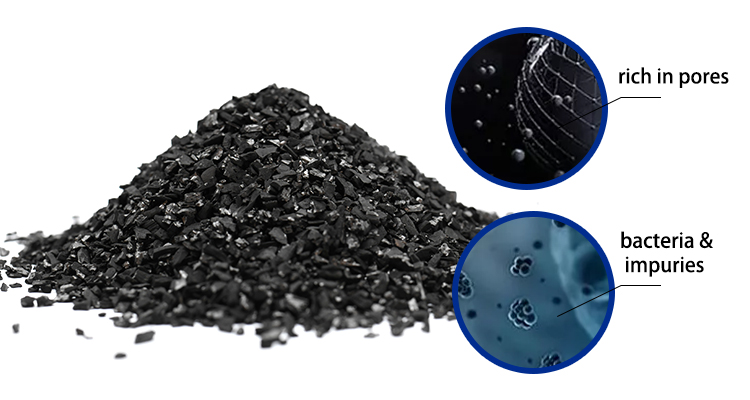Views: 275 Author: Site Editor Publish Time: 2024-06-19 Origin: Site











Chlorine is a very important substance in the process of tap water treatment. It has a very good effect on disinfection and improvement of water quality. However, the pollution caused by excessive use and residual substances cannot be ignored. With the improvement of living standards, the awareness and demand for using safe and healthy water are getting higher. Activated carbon, as a common material for water purification, has a very obvious effect on the removal of residual chlorine.
This article mainly introduces the role and harm of residual chlorine, how activated carbon removes residual chlorine, and the main indicators of activated carbon.
Residual chlorine usually comes from the step of disinfecting water during the tap water treatment process. Water plants or water treatment facilities will add chlorine disinfectants such as chlorine gas or sodium hypochlorite to the water to kill bacteria, pathogens and other microorganisms in the water. This is an important measure to ensure the safety of drinking water. If the residual chlorine concentration in tap water is too high, it will be irritating and harmful to the respiratory system. And It is easy to react with organic matter in the water to produce carcinogens such as chloroform and chloroform, so it is necessary to remove residual chlorine.
Activated carbon is usually a porous amorphous carbon in powder or granular form. It is obtained by carbonizing solid carbonaceous materials (such as coal, wood, nut shells, fruit cores, etc.) at 600-900℃ in an air-tight condition, and then oxidizing and activating them with air, carbon dioxide, water vapor or a mixture of the three at 400-900℃.

The dechlorination process is a comprehensive process of adsorption, catalysis and reaction of chlorine with carbon. In the initial stage after the activated carbon comes into contact with the residual chlorine in the water, the removal of residual chlorine is mainly by adsorption; after reaching the adsorption equilibrium, the residual chlorine concentration continues to decrease due to the action of chemical reaction.
Adsorption is the same as the adsorption of organic matter in water by activated carbon, except that the molecules of the adsorbed substance are smaller than those of organic matter. The reaction of chlorine with carbon means that the residual chlorine exists in the form of hypochlorous acid in water, and it undergoes a chemical reaction on the carbon surface. The activated carbon acts as a reducing agent to reduce the hypochlorous acid to chloride ions.
Free residual chlorine mainly refers to ClO-, HClO, Cl2, etc.
Existing form in water: H2O + Cl2 <—> H+ + Cl- + HClO
Activated carbon removes free residual chlorine:
HClO + C* = CO* + H+ + Cl-
CO* + HClO = CO2 + H+ + Cl-
It mainly refers to NH2Cl, NHCl2, NHCl3, etc.
The removal process of combined residual chlorine by activated carbon:
NH2Cl + C* + H2O = NH3 + H+ + Cl- + CO*
2NH2Cl + CO* = N2 + 2H+ + 2Cl- + H2O + C
3NH2Cl = 2HCl + N2 + NH4Cl
The amount of physical adsorption for removing chloramines is limited.

Usually, in the pre-treatment process of chlorine removal, 900mg/g iodine nut shell granular activated carbon is often applied. This type of activated carbon has many advantages, including high mechanical strength, developed pore structure, large specific surface area, fast adsorption speed, and non-toxicity. Nut shell activated carbon is widely used in the field of water treatment, especially in chlorine removal, and can effectively improve water quality.
| Item | Size(mesh) | Iodine (mg/g) | CTC (%) | Moisture (%) | Hardness (%) |
| Nut shell activated arbon | 8*30/12*40 | 900-1300 | 40-65 | <5 | >98 |
The iodine value indicates the level of unsaturation in organic compounds, measured by the grams of iodine absorbed per 100 grams of substance. This value ranges between 400 and 1300 and directly reflects the adsorption capacity of activated carbon. A higher iodine value signifies greater adsorption capability. For effective water treatment, activated carbon with an iodine value exceeding 900 is preferred.
Particle size refers to the dimensions of activated carbon particles, often denoted in mesh numbers. A higher mesh number indicates finer particles, while a lower mesh number signifies larger particles. The adsorption rate of activated carbon is inversely correlated with particle size. Smaller particles lead to faster adsorption rates, but smaller isn’t always better.
Reduced mechanical strength accompanies smaller particle sizes, making them prone to breakage and shortening the product’s lifespan. Additionally, smaller particles can increase the resistance within activated carbon tanks and lower flow rates. Thus, selecting activated carbon with an appropriate particle size is crucial. Typically, for water treatment purposes, activated carbon ranging from 8 to 30 mesh is commonly chosen.
Achieving cleaner, safer water begins with understanding the importance of effective filtration methods, such as using activated carbon to remove chlorine and other impurities. With its remarkable adsorption capabilities, activated carbon eliminates the unpleasant taste and odor of chlorine, delivering refreshingly pure drinking water.
Derun Carbon offers cutting-edge activated carbon solutions that revolutionize your water purification process, ensuring that pristine, chlorine-free water is accessible to everyone. Pursue the highest standards of water quality—contact us today!
Commonly used activated carbon decontamination techniques in water treatment industry
Activated carbon water purification effectively removes contaminants, ensuring safe drinking water
Investigate thoroughly the benefits and drawbacks associated with various forms of coal-derived act
Principle of ozone-biological activated carbon (O3-BAC) technology and its role in water treatment
